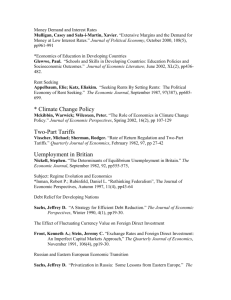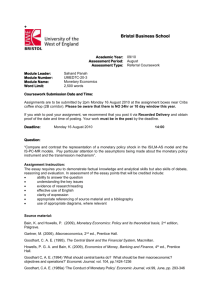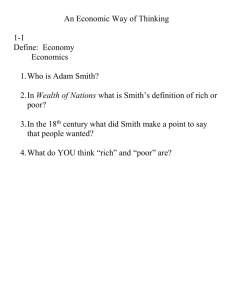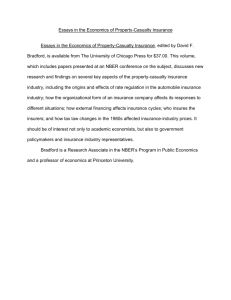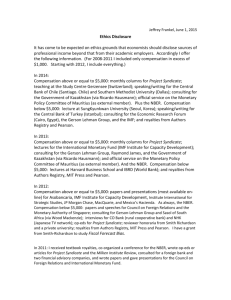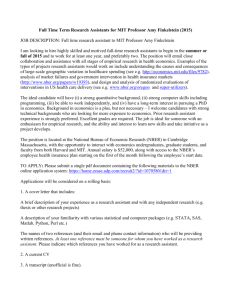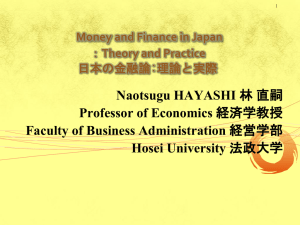Syllabus
advertisement
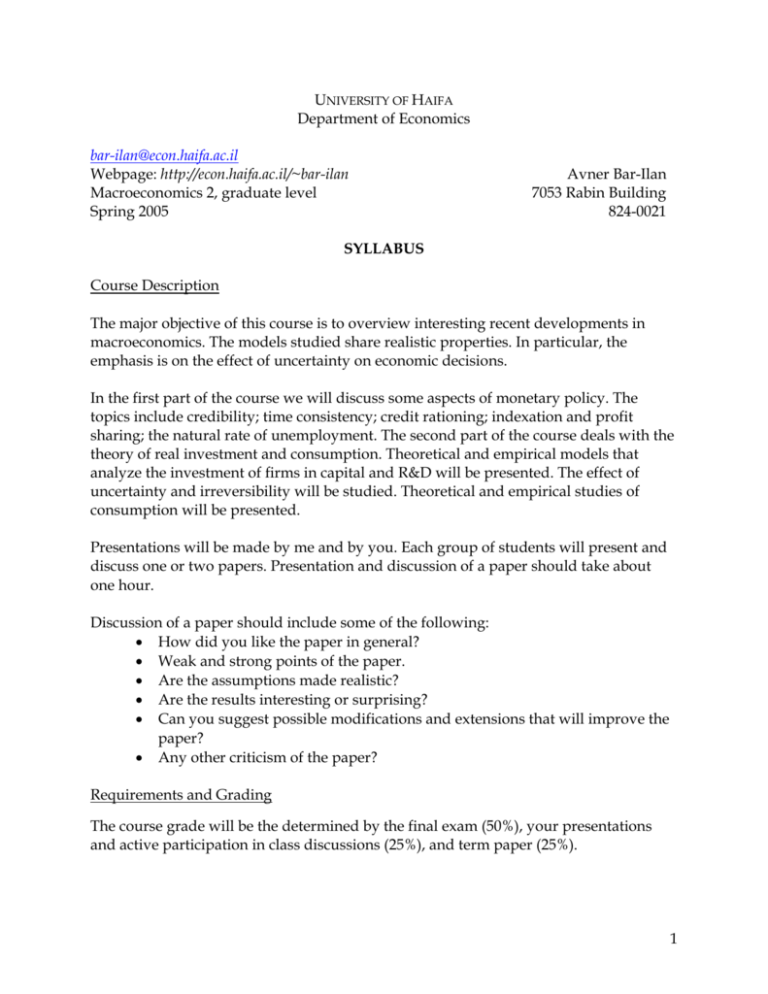
UNIVERSITY OF HAIFA Department of Economics bar-ilan@econ.haifa.ac.il Webpage: http://econ.haifa.ac.il/~bar-ilan Macroeconomics 2, graduate level Spring 2005 Avner Bar-Ilan 7053 Rabin Building 824-0021 SYLLABUS Course Description The major objective of this course is to overview interesting recent developments in macroeconomics. The models studied share realistic properties. In particular, the emphasis is on the effect of uncertainty on economic decisions. In the first part of the course we will discuss some aspects of monetary policy. The topics include credibility; time consistency; credit rationing; indexation and profit sharing; the natural rate of unemployment. The second part of the course deals with the theory of real investment and consumption. Theoretical and empirical models that analyze the investment of firms in capital and R&D will be presented. The effect of uncertainty and irreversibility will be studied. Theoretical and empirical studies of consumption will be presented. Presentations will be made by me and by you. Each group of students will present and discuss one or two papers. Presentation and discussion of a paper should take about one hour. Discussion of a paper should include some of the following: How did you like the paper in general? Weak and strong points of the paper. Are the assumptions made realistic? Are the results interesting or surprising? Can you suggest possible modifications and extensions that will improve the paper? Any other criticism of the paper? Requirements and Grading The course grade will be the determined by the final exam (50%), your presentations and active participation in class discussions (25%), and term paper (25%). 1 Office Hours My office hours are Sunday, 14-15, and Monday, after our class. However, if this is inconvenient, feel free to call or e-mail to setup a time to meet. Readings The readings for this course are on reserve at the library. At the end of every meeting, I will announce the topic of the following meeting. It is highly recommended that you will read the papers before the class. This will allow you to get the most out of the presentation and be more involved in class discussions. Course Outline Overview. Part One: Monetary Theory 1) Credibility, Time Consistency, and Monetary Policy – Theory #Barro, Robert J., and David B. Gordon, “Rules, Discretion, and Reputation in a Model of Monetary Policy,” Journal of Monetary Economics, 1983, 101-121. #Alesina, Alberto and Roberta Gatti, “Independent Central Banks: Low Inflation at No Cost?,” American Economic Review, May 1995, 196-200. Blinder, Alan, “Central Bank Credibility: Why Do We Care? How Do We Build It?,” American Economic Review, December 2000, 1421-1431, website: http://www.nber.org/papers/w7161. Blinder, Alan, “What Central Bankers Can Learn from Academics – and Vice Versa,” Journal of Economic Perspectives, Spring 1997, 3-19. McCallum, Bennett, “The Present and Future of Monetary Policy Rules,” NBER Working Paper No. W7916, September 2000, website: http://www.nber.org/papers/w7916. 2) Credibility, Time Consistency, and Monetary Policy – Empirical Work #Alesina, Alberto and Lawrence H. Summers, “Central Bank Independence and Macroeconomic Performance: Some Comparative Evidence,” Journal of Money, Credit, and Banking, 1993, 151-162. 2 Loungani, Prakash and Nathan Sheets, “Central Bank Independence, Inflation, and Growth in Transition Economies, Journal of Money, Credit, and Banking, August 1997, 381-399. Brumm, Harold J., “Inflation and Central Bank Independence: Conventional Wisdom Redux,” Journal of Money, Credit, and Banking, November 2000, 807-819. Berger, Helge, Jakob de Haan, and Sylvester Eijffinger, "Central Bank Independence: An Update of Theory and Evidence," Journal of Economic Surveys, February 2001, 3-40. 3) General Aspects of Monetary Policy # Poole, William, “Optimal Choice of Monetary Policy Instruments in a Simple Stochastic Macro Model,” Quarterly Journal of Economics, May 1970, 197-216. Blanchard, Olivier, “What do we know about Macroeconomics that Fisher and Wicksell did not?,” Quarterly Journal of Economics, November 2000, 1375-1409. website: http://www.nber.org/papers/w7550. Romer, David, “Keynesiam Macroeconomics without the LM Curve,” Journal of Economic Perspectives, Spring 2000, 149-169. website: http://www.nber.org/papers/w7461. Taylor, John, “Teaching Modern Macroeconomics at the Principles Level,” American Economic Review, May 2000, 90-94. .77-401 ,5002 ינואר,77 " סקר בנק ישראל, המקרה של ישראל: "הצצה ללשכת הנגיד,רפי מלניק 4) Indexation, Profit Sharing, and the Cost of Inflation. #Gray, JoAnna, “Wage Indexation: A Macroeconomic Approach,” Journal of Monetary Economics, 1976, 221-235. Fischer, Stanley, “Indexation and Inflation,” Journal of Monetary Economics, 1983, 519541. Wilcox, David, “The Introduction of Indexed Government Debt in the United States,” Journal of Economic perspectives, Winter 1998, 219-227. #Weitzman, Martin L., “Macroeconomic Implications of Profit Sharing,” NBER Macroeconomics Annual, 1986, 291-353. Easterly, William and Stanley Fischer, “Inflation and the Poor,” Journal of Money, Credit, and Banking, May 2001, 160-178. Di Tella, Rafael et al., “Preferences over Inflation and Unemployment: Evidence from Surveys of Happiness,” American Economic Review, March 2001, 335-341. 3 ינואר,77 " סקר בנק ישראל, שביעות רצון של הישראלים מחייהם: "אושר העממים,נעם זוסמן ודמיטרי רומנוב .402-431 ,5002 5) Credit Rationing and the Credit Channel of Monetary Policy. Stiglitz, Joseph E. and Andrew Weiss, “Credit Rationing in Markets with Imperfect Information,” American Economic Review, June 1981, 393-410. Akerlof. George, "Behavioral Macroeconomics and Macroeconomic Behavior," American Economic Review, June 2002, 411-433 (Nobel Lecture). Bernanke, Ben S., “The Macroeconomics of the Great Depression: A Comparative Approach,” Journal of Money, Credit, and Banking, February 1995, 1-28. . . and Mark Gertler, “Inside the Black Box: The Credit Channel of Monetary Policy Transmission,” Journal of Economic Perspectives, Fall 1995, 27-48. 6) Where is the Phillips Curve? Special issue on this topic, Journal of Economic Perspectives, Winter 1997. Three articles in the American Economic Review, May 1999, 52-68. Special issue on this topic, Oxford Economic Papers, January 2000. Estrella, Arturo and Frederic Mishkin, “Rethinking the Role of NAIRU in Monetary Policy: Implications of Model Formulation and Uncertainty,” in Monetary Policy Rules, edited by John Taylor, The University of Chicago Press, 1999, pp. 405-430. website: http://www.nber.org/papers/w6518. Mankiw, Gregory, “The Inexorable and Mysterious Tradeoff between Inflation and Unemployment,” NBER working Paper 7884, September 2000, website: http://www.nber.org/papers/w7884. Ball, Laurence and Gregory Mankiw, "The NAIRU in Theory and Practice," Journal of Economic Perspectives, Fall 2002, 115-136. 7) The Stock Market and Monetary Policy. Bernanke, Ben and Mark Gertler, “Should Central Banks Respond to Movements in Asset prices?,” American Economic Review, May 2001, 253-257. Longer version appears as Bernanke and Gertler, “Monetary Policy and Asset Price Volatility,” Federal Reserve Bank of Kansas City Economic Review, 4:1999, 17-52 (http://www.kc.frb.org/Publicat/econrev/PDF/4q99bern.pdf). 4 Bar-Ilan, Avner, “The Wealth Effect and Nominal Interest Rates,” working paper, December 2000 (in my website). Mankiw, Gregory and Stephen Zeldes, “The Consumption of Stockholders and Nonstockholders,” Journal of Financial Economics, 1991, 97-112. Poterba, James and Andrew Samwick, “Stock Ownership Patterns, Stock Market Fluctuations, and Consumption, Brookings Papers on Economic Activity, 2:1995, 295-357. Ludvigson, Sydney and Charles Steindel, “How important is the Stock Market Effect on Consumption?” Federal Reserve Bank of NY Economic Policy Review, July 1999, 29-51 (http://www.ny.frb.org/rmaghome/econ_pol/799lud.pdf) Dynan, Karen and Dean Maki, “Does Stock Market Wealth Matter for Consumption?,” Federal Reserve Board working paper 2001-23, May 2001. Gilchrist, Simon and John Leahy, "Monetary Policy and Asset Prices," Journal of Monetary Economics, January 2002, 75-97. Part Two: Investment 1) Investment and Uncertainty: Simple Examples. #Pindyck, Robert S., “Irreversibility, Uncertainty, and Investment,” Journal of Economic Literature, September 1991, 1110-1152. #Dixit, Avinash K. and Robert S. Pindyck, Investment under Uncertainty, Princeton University Press, 1994 (hereafter D&P), ch. 2. 2) The Timing of Investment. #Dixit, Avinash K., “Investment and Hysteresis,” Journal of Economic Perspectives, Winter 1992, 107-132. #. ., “Entry and Exit Decisions under Uncertainty,” Journal of Political Economy, June 1989, 620-638. #D&P, chs. 5-7. #Black, Fischer and Myron Scholes, “The Pricing of Options and Corporate Liabilities”, Journal of Political Economy, June 1973, 637-654. #Berk, Jonathan, “A Simple Approach for Deciding when to Invest,” American Economic Review, December 1999, 1319-1326. Rose, Colin, “The I-r hump: Irreversible Investment under Uncertainty,” Oxford Economic Papers, 2000, 626-636. 5 Doraszelski, Ulrich, “The Net Present Value Method versus the Option Value of Waiting,” Journal of Economic Dynamics and Control, August 2001, 1109-1115. Students who wish to be more acquainted with the mathematical methods (although this is not a necessary requirement for understanding and success in the course) are encouraged to consult the following. Fischer, Stanley, “The Demand for Indexed Bonds,” Journal of Political Economy, June 1975, 509-533 (especially Appendix 1). D&P, chs. 3-4. Dixit, Avinash K., “A Simplified Treatment of the Theory of Optimal Control of Brownian Motion,” Journal of Economic Dynamics and Control, October 1991, 657-673. 3) Empirical Studies: Uncertainty, Financial Constraints, and Modigliani-Miller Theorem. #Leahy, John V. and Toni M. Whited, “The Effect of Uncertainty on Investment: Some Stylized Facts,” Journal of Money, Credit, and Banking, February 1996, 64-83. Hurn, A.S. and Robert E. Wright, “Geology or Economics? Testing Models of Irreversible Investment Using North Sea Oil Data,” Economic Journal, March 1994, 363371. Moel, Alberto and Peter Tufano, “When Are Real Options Exercised? An Empirical Study of Mine Closings,” Review of Financial Studies, Spring 2002, 35-64 (skip section 4, pp. 55-62). Carruth, Alan, Dickerson, Andy and Andrew Henley, “What Do We Know about Investment under Uncertainty?” Journal of Economic Surveys”, 2000, pp. 119-153. Ferderer, J. Peter, “The Impact of Uncertainty on Aggregate Investment Spending: An Empirical Analysis,” Journal of Money, Credit, and Banking, February 1993, 30-48. Pindyck, Robert S. and Andres Solimano, “Economic Instability and Aggregate Investment,” NBER Macroeconomics Annual, 1993. Brunetti, Aymo and Beatrice Weder, "Investment and Institutional Uncertainty", The World Bank Technical Paper Number 4, 2002. http://www.ifc.org/economics/pubs/techpap4/tp4.pdf D&P, ch. 12. 4) Competitive Equilibrium and Lags. 6 Leahy, John V., “Investment in Competitive Equilibrium: The Optimality of Myopic Behavior,” Quarterly Journal of Economics, 1993, 1105-1133. #Bar-Ilan, Avner and William C. Strange, “Investment Lags,” American Economic Review, June 1996, 610-622. #Bar-Ilan, Avner and Agnes Sulem, “Time-to-Build and Capacity Choice,” Journal of Economic Dynamics and Control, January 2002, 69-98 (in my website). Pindyck, Robert S., “Investments of Uncertain Cost,” Journal of Financial Economics, August 1993, 53-76. 5) Long-Run Return, the Equity Premium Puzzle, and the Home Bias Puzzle. #Mehra, Rajnish and Edward Prescott, “The Equity Premium: A Puzzle,” Journal of Monetary Economics, 1985, 145-161. Siegel, Jeremy and Richard Thaler, “The Equity Premium Puzzle,” Journal of Economic Perspectives, Winter 1997, 191-200. Goetzmann, William and Philippe Jorion, “Global Stock Markets in the Twentieth Century,” Journal of Finance, June 1999, 953-980. Dimson, Elroy, Paul Marsh, and Mike Staunton, "Triumph of the Optimists: 101 Years of Global Investment Returns," Princeton University Press, 2002, 320 pp. Golob, John and David Bishop, “What Long-Run Returns Can Investors Expect from the Stock Market?” Federal Reserve Bank of Kansas City Economic Review, 3:1997, 5-20. Abel, Andrew, "An Exploration of the Effects of Pessimism and Doubt on Asset Returns," Journal of Economic Dynamics and Control, 2002, 1075-1092. Lewis, Karen, “Trying to Explain Home Bias in Equities and Consumption,” Journal of Economic Literature, June 1999, 571-608. 6) Are Financial Markets Efficient? Yes. Hall, Robert, “Struggling to Understand the Stock Market, American Economic Review, May 2001, 1-11. Malkiel, Burton, "The Efficient Market Hypothesis and Its Critics," Journal of Economic Perspectives, Winter 2003, 59-82. No. Shleifer, Andrei, "Inefficient Markets: An Introduction to Behavioral Finace," Oxford University Press, 200, 210 pp. 7 Shiller, Robert, "From Efficient Markets Theory to Behavioral Finance," Journal of Economic Perspectives, Winter 2003, 83-104. Also on this topic (harder!); Leroy, Stephen, "Rational Exuberance," Journal of Economic Literature, September 2004, 783-804. 7) Cash Management. Frenkel, Jacob and Boyan Jovanovic, “On Transactions and Precautionary Demand for Money,” Quarterly Journal of Economics, August 1980, 25-43. Bar-Ilan, Avner, “Overdrafts and the Demand for Money,” American Economic Review, December 1990, 1201-1216. Chang, Fwu-Ranq, “Homogeneity and the Transactions Demand for Money,” Journal of Money, Credit, and Banking, November 1999, 720-730. Symbol Key: # Presentation by Professor Bar-Ilan. 8

